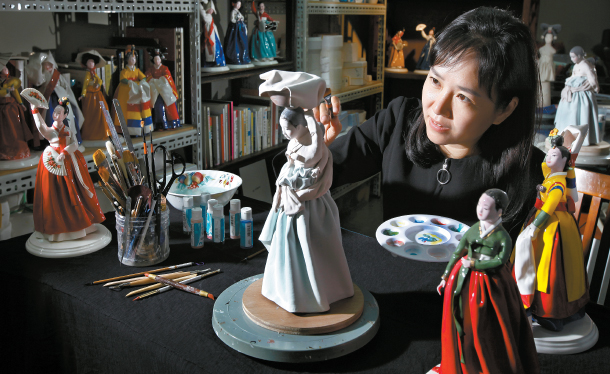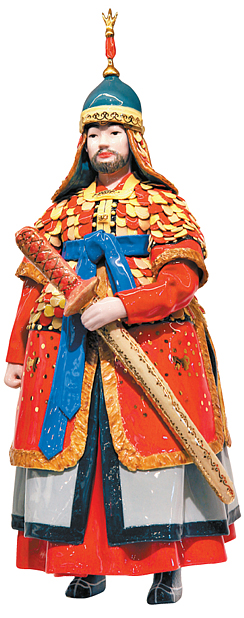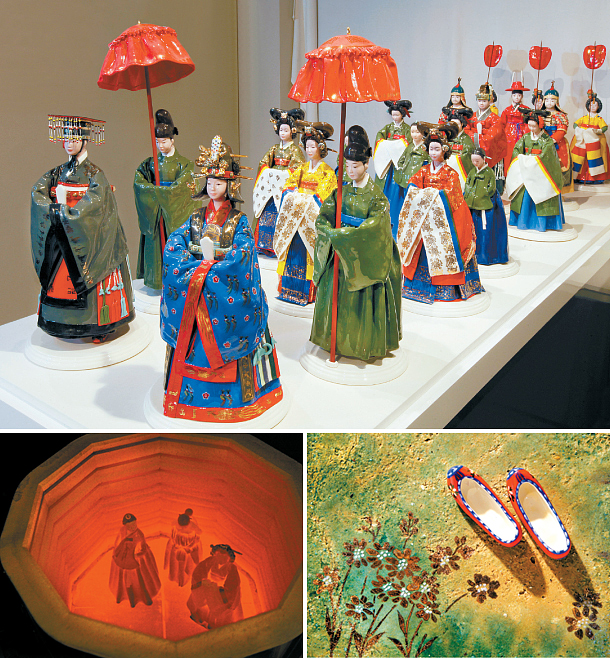[ZOOM KOREA] Ceramic dolls bring colorful history to life

Oh Joo- hyun, a porcelain artisan, colors her works after baking them in extreme heat. [PARK SANG-MOON]
Oh first started making ceramics as a hobby when she was 30. During a trip to Europe, she fell deeply in love with the porcelain figurines made by the Spanish company Lladro.

A porecelain figurine of Admiral Yi Sun-shin from the Joseon Dynasty [PARK SANG-MOON]
Her task was not easy. She had to master everything by herself, without any assistance or help from other artisans. She especially struggled with the thickness of the dolls’ clothes. When thinly-made clothes were baked in the 1,250-degree-Celsius (2,282-degree-Fahrenheit) kiln, everything collapsed. She studied for eight years to overcome this problem. It took her that long to master the methods of using soil and glaze properly.
Making the figurines true to history was no easy task either. It took thorough historical research on the customs of the Joseon Dynasty. Based on her studies, she contemplated and experimented with how to depict the figurines’ faces, clothes and colors. For Oh, 24 hours a day was not enough time to finish her work.
She also researched pigments in an attempt to find the perfect color for her dolls. The colors differed based on various circumstances such as the fire temperature in the kiln. She tried to achieve the most accurate color through repeating experiments for several years, but none of the results met her expectations. Oh’s final approach was to rely on her intuition, which proved to be the right choice in her journey of finding the perfect color.
Another difficult task was to find the right facial expression for her dolls. Oh could easily characterize other East Asian’s faces such as Chinese or Japanese, but she couldn’t figure out what distinguished Koreans from others. Although she tried to perfect Korean facial characteristics using the “Portrait of a Beauty,” one of the most famous pictures of Joseon Dynasty, she couldn’t. She finally found the face that she was looking for through religious pictures depicting Buddha. Distinct Korean facial features came out when she used eyes similar to the pictures of Buddha.
Depicting the garments worn by women in the Joseon Dynasty was as challenging as the other tasks. Instead of being garish, the clothes had to be neat and elegant, while being simple but not shabby, fit for rhythmic movements. To express the volume of the traditional Korean clothes called hanbok, the dolls wore undergarments as well. Oh covered the doll’s body with undergarments of clay, and then dressed the doll with hanbok to perfect the form.

A replica of a Korean wedding or crowning ceremony of the royal court during the Joseon Dynasty, which Oh made out of ceramics. Dolls being made inside the extremely hot, 1,250-degree-Celsius (2,282-degree-Fahrenheit) kiln. Oh’s work, “Flower Shoes,” sits on a painting with flowers. Flower shoes were traditionally made to wish whoever wears them to have only good things happen to them. [PARK SANG-MOON]
Other countries which have long traditional ceramic histories such as China, Japan and some European countries have records of making pottery from the late 17th century. However, since the majority of the ceramics in those countries are made by molds, they are less vivid and less genuine. On the other hand, Oh’s Porcelain figurines are handcrafted from start to finish, so no two pieces are identical. Each doll has its own story and warmth that cannot be felt through ceramic works which were shaped through molds.
Oh’s work also vastly differs from other countries’ ceramics because of the temperature they are formed in. Her dolls have to endure 1,250 degrees Celsius of extreme heat, which is an extremely high temperature to make ceramic dolls. Only two or three out of ten works survive in the heat. However, the completed pieces made through the elaborate process are stronger than those made in lower temperatures. More importantly, the colors come out clearer and brighter when the ceramics withstand the extreme heat.
Oh, who considers her figurines as her own offspring, has a long-cherished wish that she wants to fulfill. It is to reenact King Jeongjo (1752-1800) and his famous “Trip to Hwaseong” in porcelain. The procession was famously made up of 1,779 characters and 779 horses. The work will be no easy task to create. However, it is her life’s ambition to leave a truly great cultural legacy which will be preserved, unchanged, even after 10,000 years.
BY PARK SANG-MOON [moonpark@joongang.co.kr]










with the Korea JoongAng Daily
To write comments, please log in to one of the accounts.
Standards Board Policy (0/250자)